
자바스크립트의 경우 객체지향 언어이지만, Java와 같은 클래스 기반이 아닌 Prototype 기반 객체지향 언어이다.
💻 Prototype 객체
자바스크립트의 모든 객체는 자신의 부모 객체와 연결되어 있으며, 이러한 부모 객체를 Prototype 객체또는 Prototype이라 한다.
자바스크립트의 모든 객체들은 [[prototype]]이라는 인터널 슬롯을 가지며, __proto__로 접근가능하다. 또한 [[prototype]]의 값은 부모 객체 즉 Prototype 객체를 의미한다.
[[prototype]]의 값은 객체가 생성될 때 객체 생성 방식에 따라 결정된다. 예를 들어, 객체 리터럴에 의해 생성된 객체의 프로토타입은 Object.prototype이며, 생성자 함수로 생성된 객체의 프로토타입은 생성자 함수의 prototype 프로퍼티에 바인딩되어 있는 객체이다.
const person = {
lastName: 'Lee',
age: 25
}
console.dir(person)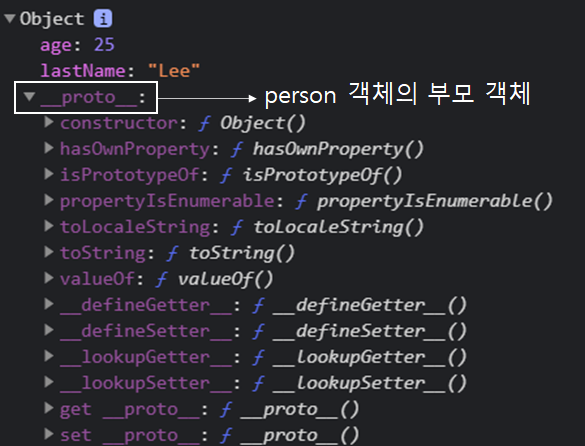
💻 [[Prototype]] VS prototype 프로퍼티
- [[Prototype]]
__proto__로 접근가능한 인터널 슬롯으로 모든 객체가 소유하고 있다. 상속을 위해 사용이 되며, 부모 객체(프로토타입 객체)를 가리키고 있다. - prototype 프로퍼티
자바스크립트의 경우 함수도 객체이다. 따라서 함수 또한 [[Prototype]]을 가지고 있다. 추가적으로 함수객체는 prototype 프로퍼티도 가지고 있다. 함수를 생성자로 사용해 객체를 생성할때 부모역할을 하는 객체(프로토타입 객체)를 가리키고 있다.
둘다 prototype 객체를 가리키고 있지만, [[prototype]]은 생성된 객체의 입장에서 부모의 객체를 가리키고 prototype 프로퍼티의 경우 생성자 함수로 생성될때 부모역할을 할 객체를 가리킨다.
function Person(lastName) {
this.lastName = lastName
}
const lee = new Person("Lee")
console.dir(Person)
console.dir(lee)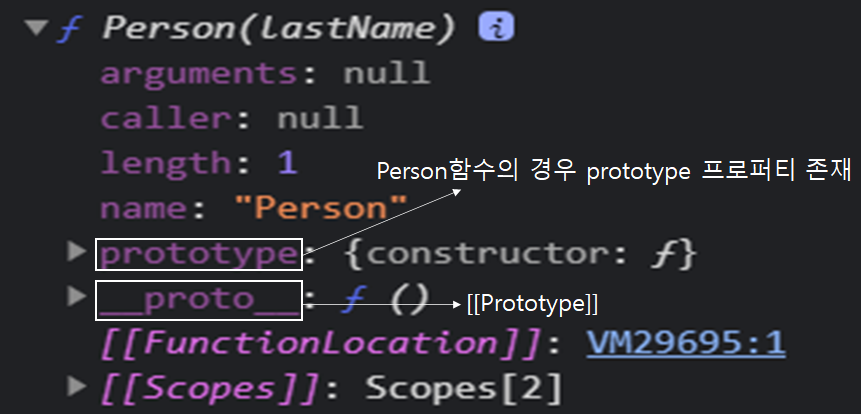

💻 constructor 프로퍼티
프로토타입 객체는 constructor 프로퍼티를 갖는다. constructor 프로퍼티는 객체의 입장에서 자신을 생성한 객체를 가리킨다.
function Person(lastName) {
this.lastName = lastName
}
const lee = new Person("Lee")위와 같은 코드를 도식화 해보면 아래와 같다.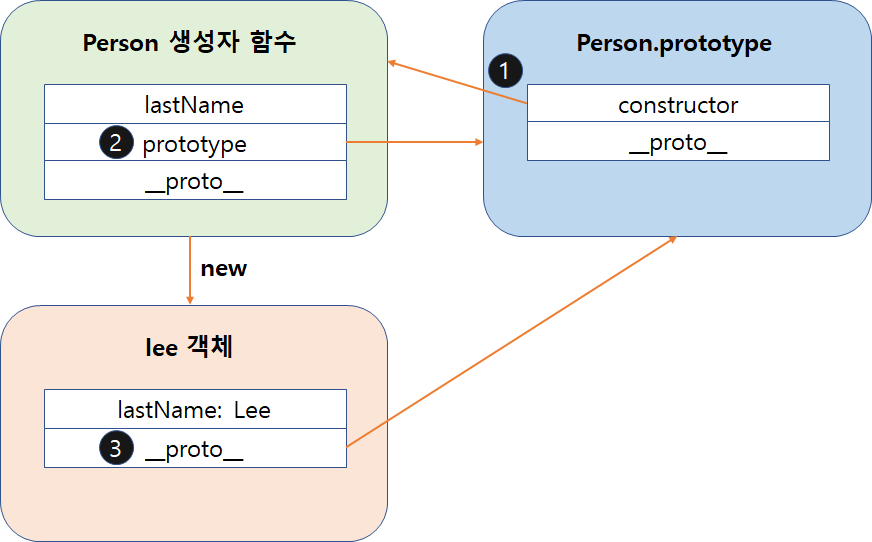
- Person의 프로토타입 객체는 constructor를 프로퍼티로 가지고 있으며 Person의 생성자 함수를 가리키고 있다.
- Person 생성자 함수의 경우 함수 객체이므로, prototype 프로퍼티를 가지고 있으며, prototype 객체를 가리키고 있다.
- Person 생성자 함수로 생성된 객체 lee는 객체이므로 [[Prototype]]을 가지고 있으며, 부모 객체인 Person.prototype객체를 가리키고 있다.
따라서 아래와 같은 결과가 나온다.
console.log(Person.prototype.constructor === Person) // true
console.log(lee.constructor === Person) // true💻 Prototype chain
특정 객체의 프로퍼티나 메소드에 접근하려 할 때, 해당 객체에 접근하려는 프로퍼티나 메소드가 없다면 [[Prototype]]을 따라 부모 객체의 프로퍼티와 메소드를 차례대로 검색한다.
✅ 객체 리터럴 방식으로 생성된 객체의 프로토타입 체인
객체 리터럴 방식으로 객체를 생성할 경우, 자바스크립트는 내부적으로 Object() 생성자 함수를 사용해 객체를 생성한다.
const lee = {
lastName: "Lee",
gender: "Male",
introduce: function() {
console.log(`I'm ${this.lastName}`)
} 위와 같이 객체를 생성할 경우 아래와 같이 표현 할 수 있다.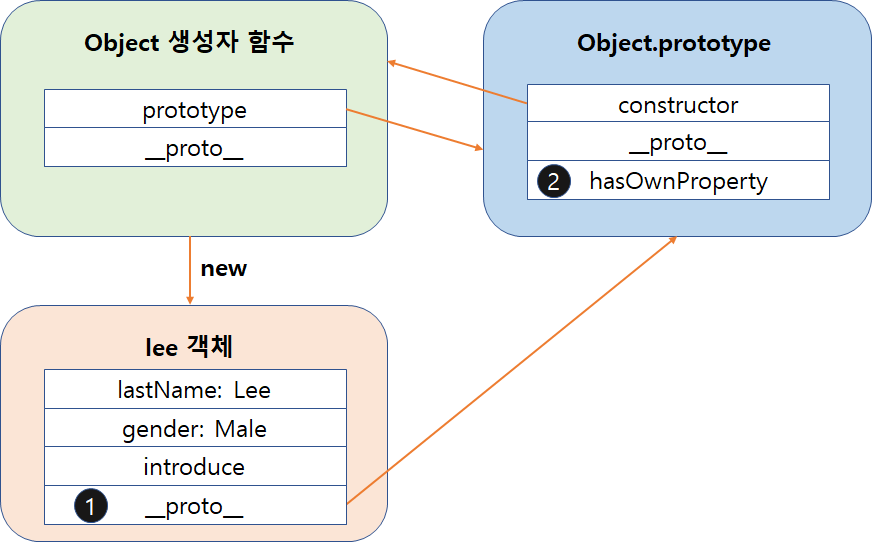
- 객체 리터럴로 생성된 lee 객체는 부모 객체로 Object.prototype 객체를 가리키고 있다.
- lee 객체에
hasOwnProperty라는 함수가 없음에도lee.hasOwnProperty("gender")가 가능한 이유는 프로토타입 체이닝으로 부모 객체를 따라 가면서hasOwnProperty메소드를 찾기 때문이다.
따라서 아래와 같은 결과가 나온다.
console.log(lee.__proto__ === Object.prototype) // true
console.log(Object.prototype.constructor === Object) // true
console.log(lee.hasOwnProperty("gender")) // true
console.log(Object.prototype.hasOwnProperty("hasOwnProperty") // true✅ 생성자 함수로 생성된 객체의 프로토타입 체인
함수를 생성자로 이용해 객체를 생성하기 위해서는 함수를 선언해야 한다. 자바스크립트에서 일반적인 함수 선언방식은 Function()을 생성자 함수로 사용해 선언하는 것과 같다.
function Person(lastName, gender) {
this.lastName = lastName
this.gender = gender
this.introduce = function() {
console.log(`I'm ${this.lastName}`)
}
}
const lee = new Person("Lee", "Male")위와 같이 객체를 생성할 경우 아래와 같이 도식화 할 수 있다.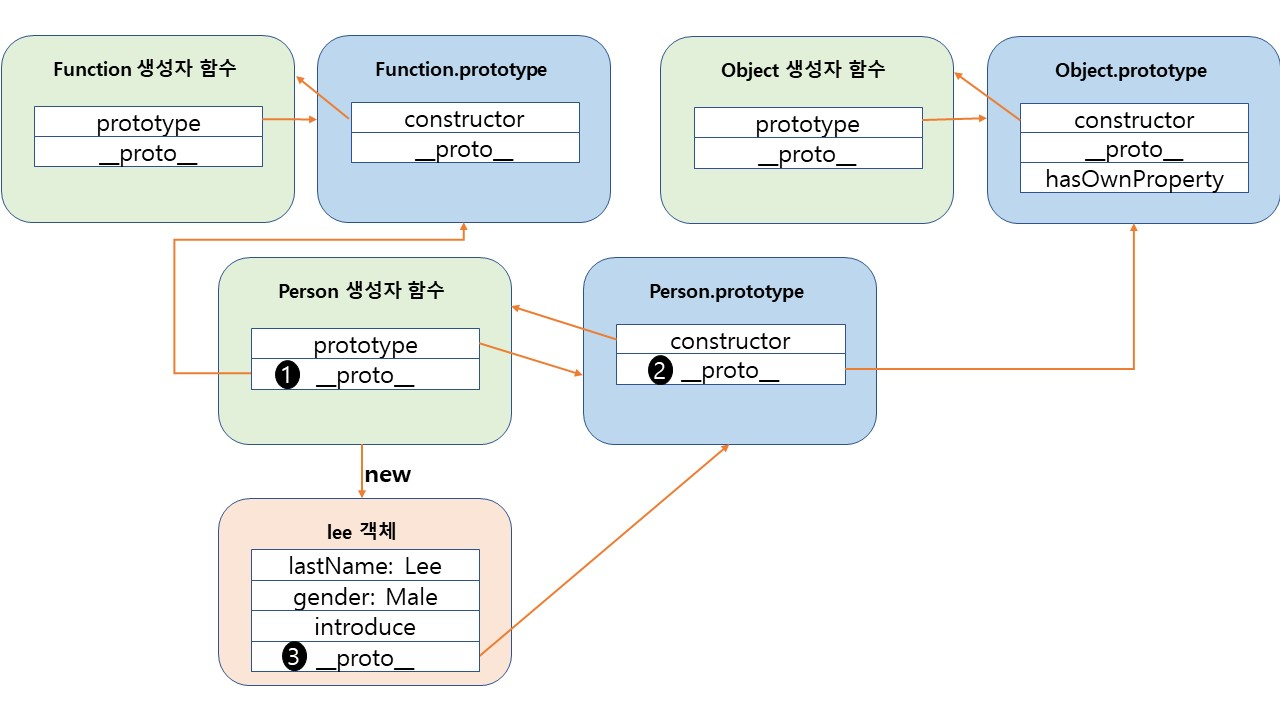
- Person 생성자 함수는 함수 객체이므로, 부모 객체로 Function prototype 객체를 가리키고 있다.
- Person prototype 객체는 일반 객체이므로, 부모 객체로 Object prototype 객체를 가리키고 있다.
- 생성자 함수로 생성된 lee객체는 부모객체로 Person의 prototype 객체를 가리키고 있다.
따라서 아래와 같은 결과가 나온다.
console.log(lee.__proto__ === Person.prototype) // true
console.log(Person.prototype.__proto__ === Object.prototype) // true
console.log(Person.prototype.constructor === Person) // true
console.log(Person.__proto__ === Function.prototype) // true
console.log(Function.prototype.__proto__ === Object.prototype) // true
console.log(Object.__proto__ === Function.prototype) // true